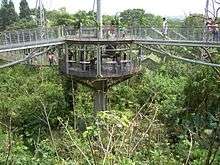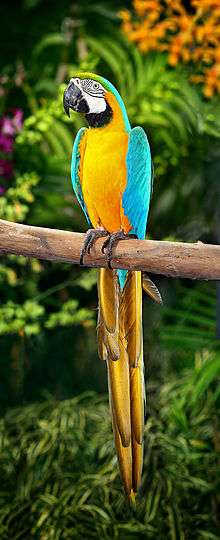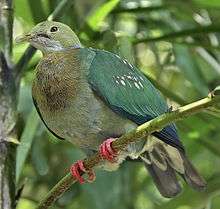Jurong Bird Park
|
Park entrance | |
| Date opened | 3 January 1971 |
|---|---|
| Location |
Jurong, Singapore 2 Jurong Hill, 628925 (1971 - 2020) Mandai, Singapore 80 Mandai Lake Road, 729826 (2020 - present) |
| Coordinates | 1°19′05″N 103°42′26″E / 1.31806°N 103.70722°ECoordinates: 1°19′05″N 103°42′26″E / 1.31806°N 103.70722°E |
| Land area | 20.2 ha (50 acres) |
| No. of animals | 5,000[1] |
| No. of species | 380[1] |
| Annual visitors | 900,000 (2010)[1] |
| Owner | Wildlife Reserves Singapore |
| Website |
www |
Jurong Bird Park is an aviary and tourist attraction in Jurong, Singapore. The bird park, managed by Wildlife Reserves Singapore, covers an area of 0.2 square kilometres (49 acres) on the western slope of Jurong Hill, the highest point in the Jurong region.
It was reported by Wildlife Reserves Singapore on 1 June 2016 that Jurong Bird Park will cease operations and be relocated to Mandai in 2020. The new park in Mandai has not been named. As for now, operation continues as per normal.[2][3]
History
The idea of a permanent aviary was first conceived by the late Dr Goh Keng Swee, then Minister for Finance, in 1968. During a World Bank Meeting in Rio de Janeiro, Dr Goh visited its zoological garden and was impressed with its free-flight aviary. He set out to ensure that Singaporeans would have a place where they could escape from urban life and relax with nature.[4]
Work on the aviary started in January 1969.[5] A 35 acre site, on the western slope of Bukit Peropok in Jurong, was chosen for the project. The bird park was expected to be completed by the end of 1969.[6]
On 3 January 1971, Jurong Bird Park, built at a cost of S$3.5 million, was opened to the public.[7]
Jurong Bird Park is now a world-famous bird zoo where there are specimens of magnificent bird life from around the world, including a large flock of flamingos. It is currently the world's largest bird park in terms of the number of birds, and second largest both in the number of bird species and land area (after Germany's Weltvogelpark Walsrode). There are 5,000 birds of 400 species in Jurong Bird Park, of which 29 are of threatened species.[1]
In 2006, Jurong Bird Park completed a S$10 million makeover. With the upgrading, the park boasts a new entrance plaza, a park-owned and managed Bongo Burgers restaurant, an ice cream parlour, a gift shop and a bird hospital.[8]
Exhibits
African Waterfall Aviary
The African Waterfall Aviary is the second largest walk-in aviary in the world, covering 2 hectares (4.9 acres) and including more than 600 free-flying birds of more than 50 species. The aviary is named after the 30-metre (98 ft) tall Jurong Falls, one of the world's tallest man-made waterfalls. Species include the golden-breasted starling, turacos and the hoopoe.
Dinosaur Descendants
In one corner of the zoo there is a section full of flightless birds: ostriches, emus, rheas and cassowaries are the residents of this exhibit.
Wings of Asia
Visitors can see the largest collection of Southeast Asian birds, which has over 200 species. There are large, central walk-in aviaries and peripheral aviaries housing the more delicate and territorial birds. A thunderstorm is simulated at noon each day, followed by a cool, light drizzle. Territorial species are kept in large cages, while species that can coexist with each other (fruit doves and pigeons being two examples) are left to roam freely in the aviary.
Lory Loft

About nine storeys high and covering 3,000 square metres (32,000 sq ft), the Lory Loft is the world's largest walk-in flight aviary for lories and lorikeets, with over 1,000 free-flying lories. The ambience is similar to that of a rainforest valley in tropical Northern Australia. Visitors can offer the lories a special nectar mix.
Penguin Coast
_(6025142541).jpg)
Houses five species of penguins within 1,600 square metres (17,000 sq ft). Featuring a 21-metre (69 ft) tall Portuguese galleon façade and designed to resemble a ship, the interior of Penguin Coast is constructed with timber beams and wooden flooring. Penguin Coast is home to the Humboldt, rockhopper, macaroni and king penguins, which live in an indoor, climate-controlled den with access to an outdoor enclosure showcasing African penguins, one of the few species that are adapted to the tropics. Joining them are cape shelducks and gulls.
World of Darkness
Asia's first nocturnal bird house features a system of reverse lighting, converting day to night and vice versa. On display are 60 birds from 17 species, like the night herons, fish owls, boobook owls and snowy owls. It is akin to a quiet nocturnal walk along a starlit jungle path, watching birds in their nocturnal surroundings and hearing them beckon each other.
Pelican Cove
Visitors catch a glimpse of all seven species of pelicans, including the endangered Dalmatian pelican. There is a board-walk where visitors can stroll and observe the birds. Visitors can also see the pelicans at the world's first underwater viewing gallery for pelicans, where the birds scoop up fish at feeding time.
Shows
High Flyers Show

This bird show has the world's largest number of performing birds in a single act. Besides highlighting the antics of talented birds like the mimicking cockatoos, this show is also a window onto the natural behaviour of birds like pelicans, flamingos and hornbills.
Kings of the Skies Show
Visitors watch birds of prey such as eagles, hawks and falcons, who will fly in loops and soar above the treetops. Visitors also learn about falconry as these birds are put through their paces in a simulated hunt.
Lunch with the Parrots
Visitors enjoy a parrot show over lunch in front of the flamingo lake.
List of birds
- Bali mynah
- Barbet
- Black hornbill
- Carmine bee-eater
- Cassowary
- Cockatoo
- Crowned crane
- Crowned pigeon
- Lesser whistling duck
- Mandarin duck
- White faced tree duck
- Eclectus parrot
- Egret
- Emu
- American flamingo
- Greater flamingo
- Lesser flamingo
- Hill myna
- Indian pied hornbill
- Lesser bird-of-paradise
- lesser blue eared starling
- Lorikeet
- Macaw
- Night heron
- Ostrich
- Barn owl
- Fish owl
- Great grey owl
- Australian pelican
- Brown pelican
- Great white pelican
- Fairy penguin
- Humboldt penguin
- King penguin
- Macaroni penguin
- Rockhopper penguin
- Purple glossy starling
- Rainbow lorikeet
- Red crested cardinal
- Rhea
- Roller
- Scarlet ibis
- Spoonbill
- Stone curlew
- Marabou stork
- Saddle-billed stork
- Shoebill stork
- Yellow billed stork
- Sun conure
- Superb starling
- Black swan
- Black-necked swan
- Mute swan
- Tanager
- Toco toucan
- Turaco
- Twelve-wired bird-of-paradise
- Wattled starling
- Weaver bird
- White-bellied sea eagle
- Whydah
- Yellow-hooded blackbird
- Yellow-naped amazon parrot
Awards
Awarded to Jurong Bird Park:[9]
- Michelin 2-star rating, 2008
- Conservation & Research Award, International Symposium on Breeding Birds in Captivity, 2006 and 2007
- Excellence Award, Association of Southeast Asian Nations Tourism Association, 2004 and 2007
- Best Loved Pro-Family Business, Singapore, 2006
- Superstar Winner of the Excellent Service Awards, Singapore Tourism Board, 2004
- Tourism Host of the Year, Singapore Tourism Board, 2003
- Breeders Award, American Pheasant and Waterfowl Society, 2001
- Highly Commended, Tourism For Tomorrow International Awards, 1993
Transport
Jurong Bird Park can be accessed on SBS Transit Service 194 from Boon Lay Bus Interchange, which has connections to the Mass Rapid Transit at Boon Lay MRT station.
Gallery
 Palm-nut vulture
Palm-nut vulture Cattle egret
Cattle egret Blue-and-yellow Macaw
Blue-and-yellow Macaw Nankeen night heron
Nankeen night heron Spangled cotinga
Spangled cotinga Black-naped oriole
Black-naped oriole Palm cockatoo
Palm cockatoo Rainbow lorikeet
Rainbow lorikeet Pink-spotted fruit-dove
Pink-spotted fruit-dove Superb starling
Superb starling Oriental pied hornbill
Oriental pied hornbill Marabou stork
Marabou stork Great blue turaco
Great blue turaco Sun parakeets
Sun parakeets
See also
| Wikimedia Commons has media related to Jurong Bird Park. |
- Gardens by the Bay, Singapore
- Night Safari, Singapore
- River Safari, Singapore
- Singapore Botanic Gardens
- Singapore Zoo
References
- 1 2 3 4 "Park experience". Jurong Bird Park.
- ↑ "Mandai Area Set for Major Redevelopment". Today. 5 Sep 2014. Retrieved 7 June 2016.
- ↑ "Mandai nature precinct will house two new wildlife parks". Channel NewsAsia. 1 Jun 2016. Retrieved 7 June 2016.
- ↑ "Goh tells why the bird park was built". The Straits Times. 4 January 1971. pp. 15–16. Retrieved 1 June 2016 – via NewspaperSG.
- ↑ Yeo, Toon Joo (3 January 1969). "Work on $1 mil. aviary at Jurong". The Straits Times. p. 6. Retrieved 1 June 2016 – via NewspaperSG.
- ↑ "Ready by end of year: Jurong's Bird Park". The Straits Times. 11 August 1969. p. 11. Retrieved 1 June 2016 – via NewspaperSG.
- ↑ "Dr. Goh Opens Park". The Straits Times. 4 January 1971. p. 1. Retrieved 1 June 2016 – via NewspaperSG.
- ↑ "The pecking order". The Straits Times. Archived from the original on 2 March 2007.
- ↑ "Accreditation and accolades". Wildlife Reserves Singapore. Retrieved 6 December 2015.
Bibliography
- Véronique Sanson (1992). Gardens and Parks of Singapore. Oxford University Press. ISBN 978-0-19-588588-0.